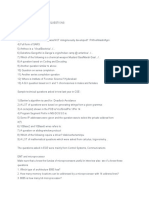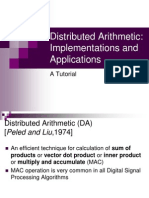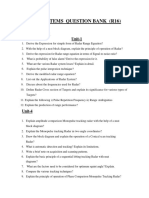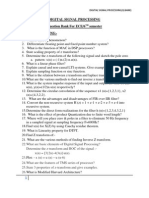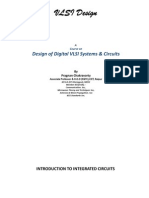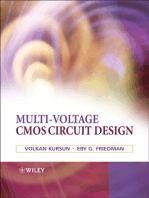ECE Interview Questions With Answers
Uploaded by
Rohit XavierECE Interview Questions With Answers
Uploaded by
Rohit XavierWhat are different categories of antenna and give an example of each?
Different categories of antenna are as follows : 1. Wire Antennas - Short Dipole Antenna 2. Microstrip Antennas - Rectangular Microstrip (Patch) Antennas 3. Reflector Antennas - Corner Reflector 4. Travelling Wave Antennas - Helical Antennas 5. Aperture Antennas - Slot Antenna 6. Other Antennas - NFC Antennas
What is handover and what are its types?
Handover in mobile communication refers to the process of transferring a call from one network cell to another without breaking the call. There are two types of handover which are as follows : Hard Handoff : hard handoff is the process in which the cell connection is disconnected from the previous cell before it is made with the new one. Soft Handoff : It is the process in which a new connection is established first before disconnecting the old one. It is thus more efficient and smart.
What is ionospheric bending?
When a radio wave travels into the ionospheric layer it experiences refraction due to difference in density. The density of ionospheric layer is rarer than the layer below which causes the radio wave to be bent away from the normal. Also the radio wave experiences a force from the ions in the ionospheric layer. If incident at the correct angle the radio wave is completely reflected back to the inner atmosphere due to total internal reflection. This phenomenon is called ionospheric reflection and is used in mobile communication for radio wave propagation also known as ionospheric bending of radio waves.
What is CDMA?
CDMA stands for Code Division Multiple Access which uses digital format. In CDMA systems several transmissions via the radio interface take place simultaneously on the same frequency bandwidth. User data is combined at the
transmitters side with a code, then transmitted. On air, all transmission get mixed. At the receiver's side the same code is used as in the transmitters side. The code helps the receiver to filter the user information of the transmitter from incoming mixture of all transmissions on the same frequency band and same time.
Explain the concept of frequency re-use.
The whole of the geographical area is divided into hexagonal shape geometrical area called cell and each cell having its own transceiver. Each BTS (cell site) allocated different band of frequency or different channel. Each BTS antenna is designed in such a way that i cover cell area in which it is placed with frequency allotted without interfering other cell signals. The design process of selecting and allocating channel groups for all of the cellular base station within system is called frequency reuse.
Explain Bluetooth.
Bluetooth is designed to be a personal area network, where participating entities are mobile and require sporadic communication with others. It is omni directional i.e. it does not have line of sight limitation like infra red does. Ericsson started the work on Bluetooth and named it after the Danish king Harold Biuetooth. Bluetooth operates in the 2.4 GHz area of spectrum and provides a range of 10 metres. It offers transfer speeds of around 720 Kbps.
7. What are GPRS services?
GPRS services are defined to fall in one of the two categories : - PTP ( Point to point) - PTM ( Point to Multipoint) Some of the GPRS services are not likely to be provided by network operators during early deployment of GPRS due in part to the phased development of standard. Market demand is another factor affecting the decision of operators regarding which services to offer first.
8. What are the advantages of CDMA?
Advantages of CDMa are as follows : 1. Frequency diversity : Transmission is spread out over a large bandwidth due
to that less affected by noise. If bandwidth is increased S/N ratio increases, which means noise will be reduced. 2. Multiplication Resistance : Chipping codes used for CDMA not only exhibit low correlation but also low autocorrelation. Hence a version of the signal that is delayed by more than one chip interval does not interfere with dominant signal as in other multipath environments. 3. Privacy : Due to spread spectrum is obtained by the use of noise like signals, where each user has a unique code, so privacy is inherent. 4. Graceful Degradation. In CDMA, more users access the system simultaneously as compared to FDMa, TDMA.
9. What are the advantages of spread spectrum?
SPread spectrum has the following advantages : 1. No crosstalk interference. 2. Better voice quality/data integrity and less static noise. 3. Lowered susceptibility to multipath fading. 4. Inherent security. 5. Co-existence. 6. Longer operating distances. 7. Hard to detect. 8. Hard to intercept or demodulate. 9. Harder to jam than narrow bands. 10. Use of ranging and radar.
10. Explain the steps involved in demodulating a signal.
Once the signal is coded, modulated and then sent, the receiver must demodulate the signal. This is usually done in two steps : 1. Spectrum spreading (e.g., direct sequence or frequency hopping) modulation is removed. 2. The remaining information bearing signal is demodulated by multiplying with a local reference identical in structure and synchronised with received signal.
11. How can a Pseudo Random Noise COde be usable?
To be usable for direct sequence spreading, a PN code must meet the following conditions : 1. Sequence must be built from 2 levelled numbers.
2. The codes must have sharp autocorrelation peak to enable code synchronization. 3. Codes must have a low cross-correlation value, the lower it is, more are the number of users which can be allowed in the system. 4. The codes should be balanced i.e. the difference between ones and zeros in code may only be 1.
12. What are the drawbacks of walsh codes?
Walsh codes have the following drawbacks : 1. The codes do not have a single, narrow autocorrelation peak. 2. The spreading is not over the whole bandwidth; instead the energy is spread over a number of discrete frequency components. 3. Although the full sequence cross correlation is identically zero, this does not hold for a partial sequence cross correlation function. Thus advantage of using orthogonal codes is lost. 4. Orthogonality is also affected by channel properties like multi path.
13. Explain radio environment in building.
Building penetration : Building penetration depends on the material used for construction and architecture used. This varies building to building and is based on building construction. Building Height Effect : The signal strength is always higher at top floor and generally floor gain height is about 2.7dB/floor which is not dependent on building construction. Building Floor Reception : The signal isolation between floors in a multi floor building is on the average about 20dB. Within a floor of 150 * 150 feet, the propagation loss due to interior walls, depending on the wall materials is about 20 dB between the strong and the weak areas.
14. List some advantages of GSM.
Here are some advantages of GSM : 1. GSM is mature, this maturity means a more stable network with robust features. 2. Less signal deterioration inside buildings. 3. Ability to use repeaters. 4. Talk time is generally higher in GSM phones due to pulse nature of transmission.
5. The availability of Subscriber Identity Modules allows users to switch networks and handset at will. 6. GSM covers virtually all parts of world so international roaming is not a problem.
15. What are the various types of numbers for network identity?
Various types of number for network identity are as follows : 1. MSISDN ( Mobile station ISDN) Number : It is international mobile subscriber number which is normally called mobile number. It is unique worldwide. 2. MSRN ( Mobile Subscriber Routing Number) : MSRN is used during mobile terminate trunk call to provide location of mobile subscriber. 3. HON ( Hand Over Number ) : HON is used for providing information required to transfer call from one B?SC to another BSC or to another MSC. 4. ISMI ( International Mobile Subscriber Identity Number) : Purpose of ISMI is for location update and authentication. 5. TMSI ( Temporary Mobile Subscriber Identity ) : TMSI is used instead of IMSI to improve security efficiency of network. 6. IMEI : International Mobile Equipment Identity.
16. What are the functions of Base Station System ( BSS)?
Functions of BSS are as follows : 1. Radio path control. 2. BTS and TC control. 3. Connection establishment with MS-NSS. 4. Mobility management, speech transcoding. 5. Connection of statistical data.
17. What are the parts of Network Management System ( NMS )?
Following are the parts of network management system : 1. OMC : Operation and maintenance center - Computerized monitoring center. 2. NMC : Network Management Center - Centralized control of a network is done here. 3. OSS : Operation and support system - Used for supporting activities performed in an OMC and/or NMC.
18. What are applications of DSP?
Some selected applications or digital signal processing that are often encountered in daily life are listed as follows: 1. Telecommunication: Echo cancellation in telephone networks. 2. Military Radar signal processing 3. Consumer electronics Digital Audio/TV 4. Instrumentation and control 5. Image processing image representation, image compression 6. Speech processing speech analysis methods are used in automatic speech recognition 7. Medicine Medical diagnostic instrumentation such as computerised tomography (CT) 8. Seismology DSP techniques are employed in geophysical exploration for oil and gas. 9. Signal Filtering Removal of unwanted background noise.
19. What is analog-to-digital conversion of signals?
A discrete-time signal is defined by specifying its value only at discrete times, called sampling instants. When the sampled values are quantised and encoded, a digital signal is obtained. A digital signal is obtained from the analog signal by using an analog-to-digital converter. This entire process is referred to as the conversion of signals from analog to digital form.
20. What are the properties of ROC for z-Transform?
Properties of the ROC for the z-Transform : 1. X(z) converges uniformly if and only if the ROC of the z-transform X(z) of the sequence includes the unit circle. The ROC of X(z) consists of a ring in the zplane centered about the origin. That is, the ROC of the z-transform of x(n) has values of z for which x(n) r-n is absolutely summable. 2. The ROC does not contain any poles. 3. When x(n) is of finite duration then the ROC is the entire z-plane, except possibly z=0 and/or z=infinity. 4. If x(n) is a right sided sequence, the ROC will not include infinity. 5. If x(n) is a left sided sequence, the ROC will not include z=0. However if x(n)=0 for all n>0, the ROC will include z=0. 6. If x(n) is two sided and if the circle |z| = r0 is in the ROC, then the ROC will consist of a ring in the z-plane that includes the circle |z|=r0. 7. If X(z) is rational, then the ROC extends to infinity, i.e. the ROC is bounded
by poles. 8. If x(n) is causal, then the ROC includes z=infinity. 9. If x(n) is anti- causal, trhen the ROC includes z=0.
You might also like
- RF Analog Impairments Modeling for Communication Systems Simulation: Application to OFDM-based TransceiversFrom EverandRF Analog Impairments Modeling for Communication Systems Simulation: Application to OFDM-based TransceiversNo ratings yet
- Low Power VLSI Circuits & Systems Complete Notes100% (1)Low Power VLSI Circuits & Systems Complete Notes66 pages
- ISRO Rank-1 EC Interview Experience - QuoraNo ratings yetISRO Rank-1 EC Interview Experience - Quora3 pages
- EC3492-DIGITAL SIGNAL LABORATORY ManualNo ratings yetEC3492-DIGITAL SIGNAL LABORATORY Manual48 pages
- Analog Electronics Viva & Interview Questions: by Prof. Hitesh Dholakiya Engineering Funda Youtube ChannelNo ratings yetAnalog Electronics Viva & Interview Questions: by Prof. Hitesh Dholakiya Engineering Funda Youtube Channel45 pages
- Ldica Course Info Sheet and Question BankNo ratings yetLdica Course Info Sheet and Question Bank28 pages
- Experiment: 06: AIM: To Design and Simulate Ring Oscillator Using Cadence and Compare The Delay BetweenNo ratings yetExperiment: 06: AIM: To Design and Simulate Ring Oscillator Using Cadence and Compare The Delay Between3 pages
- EC6016 Opto Electronic Devices University Question Paper Nov Dec 2017No ratings yetEC6016 Opto Electronic Devices University Question Paper Nov Dec 20172 pages
- Applied Mathematics For Electronics EngineersNo ratings yetApplied Mathematics For Electronics Engineers35 pages
- Technological Innovation Management and Entrepreneurship: Model Question Paper - With Effect From 2020-21 (CBCS Scheme)No ratings yetTechnological Innovation Management and Entrepreneurship: Model Question Paper - With Effect From 2020-21 (CBCS Scheme)7 pages
- Advanced Communication Lab Manual-15ECL76 FinalNo ratings yetAdvanced Communication Lab Manual-15ECL76 Final41 pages
- RTL Simulation and Synthesis With PLDs QP Mid-10% (1)RTL Simulation and Synthesis With PLDs QP Mid-11 page
- EC8353 Electron Devices and Circuits - Course Page - College WebsiteNo ratings yetEC8353 Electron Devices and Circuits - Course Page - College Website4 pages
- Testing of Vlsi Circuits: Answer All Questions Each Question Carries 25 MarksNo ratings yetTesting of Vlsi Circuits: Answer All Questions Each Question Carries 25 Marks2 pages
- Distributed Arithmetic: Implementations and Applications: A TutorialNo ratings yetDistributed Arithmetic: Implementations and Applications: A Tutorial30 pages
- Radar Systems Question Bank (R16) : Essay Questions: Unit-1No ratings yetRadar Systems Question Bank (R16) : Essay Questions: Unit-13 pages
- Binary Phase Shift Keying (BPSK) Modulation Using CD4016 With Simulated Output Waveform - Circuits Gallery PDFNo ratings yetBinary Phase Shift Keying (BPSK) Modulation Using CD4016 With Simulated Output Waveform - Circuits Gallery PDF11 pages
- UGC NET Electronic Science Paper II Jun 05No ratings yetUGC NET Electronic Science Paper II Jun 0512 pages
- DSP Interview Questions March-2019: ANSWER: A/D ConverterNo ratings yetDSP Interview Questions March-2019: ANSWER: A/D Converter13 pages
- Communications Interview Questions and AnswersNo ratings yetCommunications Interview Questions and Answers7 pages
- Electronic Communications Interview Questions & AnswersNo ratings yetElectronic Communications Interview Questions & Answers8 pages
- Electronic Communications Interview Questions and AnswersNo ratings yetElectronic Communications Interview Questions and Answers8 pages
- Viva Questions For Mobile Communications and Satellite Communication100% (2)Viva Questions For Mobile Communications and Satellite Communication8 pages
- Cs2402 - Mobile and Pervasive Computing Unit 1: Ans: AdvantagesNo ratings yetCs2402 - Mobile and Pervasive Computing Unit 1: Ans: Advantages4 pages
- FPGA Implementation of Pipelined 2D-DCT and Quantization Architecture For JPEG Image CompressionNo ratings yetFPGA Implementation of Pipelined 2D-DCT and Quantization Architecture For JPEG Image Compression2 pages
- Principles of Deadlock: by M.Rohit Xavier B.Tech, Iiiyear, EceNo ratings yetPrinciples of Deadlock: by M.Rohit Xavier B.Tech, Iiiyear, Ece16 pages
- Line Follower ROBOT Micro Controller 8051No ratings yetLine Follower ROBOT Micro Controller 805128 pages
- Sailor H2192 GMDSS Service Manual (Original Manual)No ratings yetSailor H2192 GMDSS Service Manual (Original Manual)50 pages
- Telecommunications, The Internet, and Wireless TechnologyNo ratings yetTelecommunications, The Internet, and Wireless Technology24 pages
- 790 - 2200 MHZ Base Station Antennas For Mobile CommunicationsNo ratings yet790 - 2200 MHZ Base Station Antennas For Mobile Communications186 pages
- R4-200XXXX (94e-Bis) (14) NR - RF - FR1 - Part - 1 - v0 - SKW - Qualcomm - ZTENo ratings yetR4-200XXXX (94e-Bis) (14) NR - RF - FR1 - Part - 1 - v0 - SKW - Qualcomm - ZTE33 pages
- WBAN - Presentation - Wireless NetworksNo ratings yetWBAN - Presentation - Wireless Networks46 pages
- RF Smart Repeater: Model SR731 Installation and Operating InstructionsNo ratings yetRF Smart Repeater: Model SR731 Installation and Operating Instructions1 page
- Inset Fed Microstrip Patch Antenna For Wireless Communication at 2.45No ratings yetInset Fed Microstrip Patch Antenna For Wireless Communication at 2.456 pages
- Fault Tolerant & Fault Testable Hardware DesignFrom EverandFault Tolerant & Fault Testable Hardware Design
- RF Analog Impairments Modeling for Communication Systems Simulation: Application to OFDM-based TransceiversFrom EverandRF Analog Impairments Modeling for Communication Systems Simulation: Application to OFDM-based Transceivers
- Analog Electronics Viva & Interview Questions: by Prof. Hitesh Dholakiya Engineering Funda Youtube ChannelAnalog Electronics Viva & Interview Questions: by Prof. Hitesh Dholakiya Engineering Funda Youtube Channel
- Experiment: 06: AIM: To Design and Simulate Ring Oscillator Using Cadence and Compare The Delay BetweenExperiment: 06: AIM: To Design and Simulate Ring Oscillator Using Cadence and Compare The Delay Between
- EC6016 Opto Electronic Devices University Question Paper Nov Dec 2017EC6016 Opto Electronic Devices University Question Paper Nov Dec 2017
- Technological Innovation Management and Entrepreneurship: Model Question Paper - With Effect From 2020-21 (CBCS Scheme)Technological Innovation Management and Entrepreneurship: Model Question Paper - With Effect From 2020-21 (CBCS Scheme)
- EC8353 Electron Devices and Circuits - Course Page - College WebsiteEC8353 Electron Devices and Circuits - Course Page - College Website
- Testing of Vlsi Circuits: Answer All Questions Each Question Carries 25 MarksTesting of Vlsi Circuits: Answer All Questions Each Question Carries 25 Marks
- Distributed Arithmetic: Implementations and Applications: A TutorialDistributed Arithmetic: Implementations and Applications: A Tutorial
- Radar Systems Question Bank (R16) : Essay Questions: Unit-1Radar Systems Question Bank (R16) : Essay Questions: Unit-1
- Binary Phase Shift Keying (BPSK) Modulation Using CD4016 With Simulated Output Waveform - Circuits Gallery PDFBinary Phase Shift Keying (BPSK) Modulation Using CD4016 With Simulated Output Waveform - Circuits Gallery PDF
- DSP Interview Questions March-2019: ANSWER: A/D ConverterDSP Interview Questions March-2019: ANSWER: A/D Converter
- Electronic Communications Interview Questions & AnswersElectronic Communications Interview Questions & Answers
- Electronic Communications Interview Questions and AnswersElectronic Communications Interview Questions and Answers
- Viva Questions For Mobile Communications and Satellite CommunicationViva Questions For Mobile Communications and Satellite Communication
- Cs2402 - Mobile and Pervasive Computing Unit 1: Ans: AdvantagesCs2402 - Mobile and Pervasive Computing Unit 1: Ans: Advantages
- FPGA Implementation of Pipelined 2D-DCT and Quantization Architecture For JPEG Image CompressionFPGA Implementation of Pipelined 2D-DCT and Quantization Architecture For JPEG Image Compression
- Principles of Deadlock: by M.Rohit Xavier B.Tech, Iiiyear, EcePrinciples of Deadlock: by M.Rohit Xavier B.Tech, Iiiyear, Ece
- Sailor H2192 GMDSS Service Manual (Original Manual)Sailor H2192 GMDSS Service Manual (Original Manual)
- Telecommunications, The Internet, and Wireless TechnologyTelecommunications, The Internet, and Wireless Technology
- 790 - 2200 MHZ Base Station Antennas For Mobile Communications790 - 2200 MHZ Base Station Antennas For Mobile Communications
- R4-200XXXX (94e-Bis) (14) NR - RF - FR1 - Part - 1 - v0 - SKW - Qualcomm - ZTER4-200XXXX (94e-Bis) (14) NR - RF - FR1 - Part - 1 - v0 - SKW - Qualcomm - ZTE
- RF Smart Repeater: Model SR731 Installation and Operating InstructionsRF Smart Repeater: Model SR731 Installation and Operating Instructions
- Inset Fed Microstrip Patch Antenna For Wireless Communication at 2.45Inset Fed Microstrip Patch Antenna For Wireless Communication at 2.45


